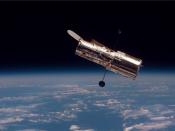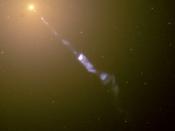Have you ever been watching Star Treck on T.V. and heard them mention something about black holes? Well, do you know what a black hole is? A black hole is so dense and has a gravity so strong, that they have an escape velocity, or the point in the black hole where objects can no longer return to space, of 299,792,458 meters per second. They can be as tiny as the point of a pin or as massive as fifty billion times the mass of our sun, Sol.
Boom! Bam! WHAM! An "invisible star" was discovered by French astronomer Pierre-Simon LaPlace and English geologist John Mitchel (you could put the date here if you want to). While gazing into the heavens, LaPlace and Mitchell discovered a black hole. They calculated the mass and size needed in order to get an escape velocity greater than the speed of light.
Black holes may seem very complicated, however, they are composed of only four parts.
The first part is called the singularity. The singularity is simply the collapsed core. Next, is the event horizon, or the opening of the hole to which matter goes in. The third part is the ergosphere; it is the egg-shaped region of distorted, or malformed, space around the event horizon. Last, is the static limit, or the boundary between the ergospere and the normal space.
According to popular thought, there are three types of black holes - super massive, miniature, and stellare black holes. Black holes are classified depending on their size and mass. Super massive black holes are known to exist in the center of galaxies, including the galaxy in which we live, the Milky Way galaxy. Some supre massive black holes have a mass greater than or equal to the mass of our sun, Sol. Miniature...



I really like your beginning!
I really like the beginning of your essay! Really hooked me in. To bring something that some people can relate to (Star Trek) so you could catch the readers' attention. Good job!
4 out of 4 people found this comment useful.